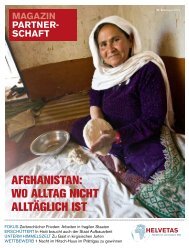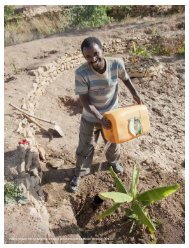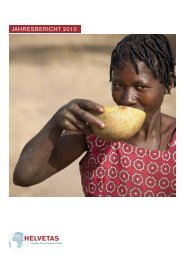Report Feasibility study organic bitter tea Cao Bang - Helvetas
Report Feasibility study organic bitter tea Cao Bang - Helvetas
Report Feasibility study organic bitter tea Cao Bang - Helvetas
Create successful ePaper yourself
Turn your PDF publications into a flip-book with our unique Google optimized e-Paper software.
1. INTRODUCTION<br />
<strong>Feasibility</strong> Study Organic Bitter Tea in <strong>Cao</strong> <strong>Bang</strong>: 2007<br />
<strong>Cao</strong> <strong>Bang</strong> province is known as being a poor, remote, mountainous area with 77% of its<br />
total area covered by forest. 86% of the area’s population earns its livelihood from<br />
agriculture and forestry. However, <strong>Cao</strong> <strong>Bang</strong> has a favourable climate and forest area<br />
suited to the development of <strong>bitter</strong> <strong>tea</strong>, a high value medicinal plant.<br />
In the frame of its community based Governance, Extension, Marketing project in <strong>Cao</strong><br />
<strong>Bang</strong> (CB-GEM), <strong>Helvetas</strong> Vietnam supported the Bitter Tea Company in <strong>Cao</strong> <strong>Bang</strong> to<br />
carry out a rapid market appraisal which identified many strengths and weaknesses of the<br />
<strong>bitter</strong> <strong>tea</strong> market. The CB-GEM project then supported the company to establish an action<br />
plan to improve the <strong>bitter</strong> <strong>tea</strong> market situation. One of the identified topics of this action<br />
plan is to carry out a feasibility <strong>study</strong> of <strong>organic</strong> <strong>bitter</strong> <strong>tea</strong> production in <strong>Cao</strong> <strong>Bang</strong>. The<br />
results of this <strong>study</strong> should then be used by the decision makers to decide if it would be<br />
worth or not to start a certified <strong>organic</strong> production for a specifically identified market.<br />
2. BACKGROUND<br />
2.1. Context of <strong>Cao</strong> <strong>Bang</strong> Province<br />
<strong>Cao</strong> <strong>Bang</strong> is a mountainous province with diversified agro-ecological conditions located in<br />
the North of Vietnam. It borders China along more than 300 km. It has a total area of some<br />
6700 km², in which about 77% is covered by forested hills and low mountains (500–1000<br />
m, with some reaching 1900 m). Therefore, <strong>Cao</strong> <strong>Bang</strong> possesses great potential for the<br />
development of natural resources and high-value agricultural and forestry products.<br />
<strong>Cao</strong> <strong>Bang</strong> has a total population of 513,700, where ethnic minority communities make up<br />
more than 95% of the total population across seven different ethnic groups (<strong>Cao</strong> <strong>Bang</strong><br />
Statistics Office, 2005). It is one of the poorest provinces in Vietnam, ranked 60th in the<br />
Millennium Development Goal (MDG) index and the 50th in the poverty index out of 64<br />
provinces of Vietnam (UNDP, 2005). Agricultural production is the most important and<br />
dominant economic sector. It provides the main livelihoods of the population and it is<br />
considered that it will be the province’s economic foundation for the next 20 years (IFAD,<br />
2006).<br />
2.2. Background information on <strong>bitter</strong> <strong>tea</strong><br />
Bitter <strong>tea</strong> is the name for a beverage obtained from various species of the plant genus Ilex.<br />
In Vietnam, <strong>bitter</strong> <strong>tea</strong> (or "cha dang") is obtained from Ilex kaushue, which is distributed in<br />
the North of Vietnam, mainly in <strong>Cao</strong> <strong>Bang</strong> province but also in Ha Giang and a few other<br />
provinces. In China, two groups of plants were traditionally being utilized for <strong>bitter</strong> <strong>tea</strong> (or<br />
"Ku Ding Cha"): several Ilex species and the wax tree (Ligustrum robustum). Today, it is<br />
estimated that more than 90% of the Ku Ding Cha used in China is from an Ilex, mainly<br />
Ilex kudingcha (though other Ilex species, such as Ilex latifolia, may be used), while several<br />
species of Ligustrum are substituted in Sichuan Province and in Japan. (Dharmananda,<br />
2002). Both in Vietnam and China the leaves of <strong>bitter</strong> <strong>tea</strong> are prepared and consumed in a<br />
way similar to green <strong>tea</strong>.<br />
In South America many species of Ilex are used for several popular <strong>tea</strong>-like beverages. Ilex<br />
paraguariensis is used to make yerba mate. Drinking mate with friends from a shared<br />
hollow gourd is an extremely common social practice in many South American countries<br />
- 1 -










